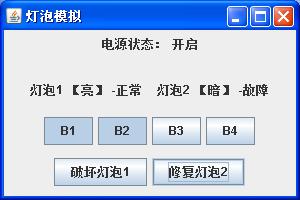灯泡异常问题模拟^^
假设需要制造一个带有四个按钮和两个灯泡的盒子并具有以下功能:
- 有四个按钮输入,分别称为B1,B2,B3和B4;
- 有两个灯泡作为输出,分别称为L1和L2;
- B1是打开电源的按钮;
- B4是关闭电源的按钮;
- B2和B3 是操作按钮;
- 在B1被按下后及B4被按下前,系统应称为电源打开状态;
- 在B4被按下后及B1被按下前,系统应称为电源关闭状态;
- 在电源关闭状态下,B2和B3按钮不起作用;
- 在电源关闭状态下,灯应不亮;
- 从最近一次电源打开状态算起,如果B2被按下的次数比B3被按下的次数多,L1亮,否则L2亮。
- 任何时候都不能有一个以上的灯泡亮;
- 如果其中的一个灯泡出现故障,另一个灯泡应以2秒钟的间隔闪烁,而不管B2和B3的操作过程。当B4按下时,闪烁停止;当B1被按下时,闪烁重新开始。当故障被排除后闪烁停止,系统恢复正常状态。
在问问上看到的问题 = = 觉得好玩就模拟了,代码比较乱 > <
另外有些修改了题目的地方:
- 设置成B1按下时B4弹起,B4按下时B1弹起,不然有的时候电源是开是关不好判定。。如果B1/B4是一个按钮就好了 = =。
- 为方便观察,间隔时间设为0.5s。
- 另外加了两个按钮用来控制灯泡1、2是否故障。
-
import java.awt.*;
-
import java.awt.event.*;
-
import javax.swing.*;
-
-
{
-
-
private final int INTER_SECOND = 500; // 间隔时间
-
-
private BulbButton b1 = new BulbButton("B1");
-
private BulbButton b2 = new BulbButton("B2");
-
private BulbButton b3 = new BulbButton("B3");
-
private BulbButton b4 = new BulbButton("B4");
-
-
private BulbLight l1 = new BulbLight(1);
-
private BulbLight l2 = new BulbLight(2);
-
-
-
-
private CheckLightThread thread;
-
-
public Bulb() {
-
this.setTitle("灯泡模拟");
-
this.setSize(300, 200);
-
-
{
-
this.add(state);
-
}
-
});
-
-
{
-
this.add(l1);
-
this.add(l2);
-
}
-
});
-
-
{
-
this.add(b1);
-
this.add(b2);
-
this.add(b3);
-
this.add(b4);
-
}
-
});
-
-
{
-
this.add(bb1);
-
this.add(bb2);
-
}
-
});
-
-
setButtons();
-
-
this.setVisible(true);
-
}
-
-
private void setButtons() {
-
b2.setEnabled(false);
-
b3.setEnabled(false);
-
b4.setSelected(true);
-
-
b1.changeState();
-
if(b1.isSelected()) {
-
b4.setSelected(false);
-
b2.setEnabled(true);
-
b3.setEnabled(true);
-
} else {
-
b2.setSelected(false);
-
b3.setSelected(false);
-
b4.setSelected(true);
-
b2.setEnabled(false);
-
b3.setEnabled(false);
-
}
-
changeSystemState();
-
}
-
});
-
-
if(!b1.isSelected() && b4.isSelected()) return; // 在电源关闭状态下,B2和B3按钮不起作用
-
b2.changeState();
-
if(b2.getCount() > b3.getCount()) { // 如果B2被按下的次数比B3被按下的次数多,L1亮
-
l1.change(true);
-
l2.change(false);
-
}
-
}
-
});
-
-
if(!b1.isSelected() && b4.isSelected()) return; // 在电源关闭状态下,B2和B3按钮不起作用
-
b3.changeState();
-
if(b3.getCount() >= b2.getCount()) { // 如果B2被按下的次数比B3被按下的次数少,L2亮
-
l1.change(false);
-
l2.change(true);
-
}
-
}
-
});
-
-
b4.changeState();
-
if(b4.isSelected()) {
-
b1.setSelected(false);
-
b2.setSelected(false);
-
b3.setSelected(false);
-
b2.setEnabled(false);
-
b3.setEnabled(false);
-
} else {
-
b1.setSelected(true);
-
b2.setEnabled(true);
-
b3.setEnabled(true);
-
}
-
changeSystemState();
-
}
-
});
-
}
-
-
private void changeSystemState() {
-
if(!b1.isSelected() && b4.isSelected()) { // 在电源关闭状态下,灯应不亮
-
state.setText("关闭");
-
l1.change(false);
-
l2.change(false);
-
thread.pause();
-
}
-
if(b1.isSelected() && !b4.isSelected()) { // 从最近一次电源打开状态算起
-
state.setText("开启");
-
b2.clearCount();
-
b3.clearCount();
-
thread = new CheckLightThread();
-
thread.start();
-
}
-
}
-
-
{
-
new Bulb();
-
}
-
-
{
-
private int count = 0;
-
-
super(text);
-
}
-
-
public void changeState() {
-
if(isSelected()) {
-
++count;
-
}
-
}
-
-
public void clearCount() {
-
count = 0;
-
}
-
-
public int getCount() {
-
return count;
-
}
-
-
}
-
-
{
-
-
private int id;
-
-
private boolean bad;
-
-
private boolean lightState;
-
-
private JLabel label;
-
-
-
-
public BulbLight(int id) {
-
this.id = id;
-
this.add(label);
-
this.add(state);
-
this.add(state2);
-
}
-
-
public int getId() {
-
return id;
-
}
-
-
public void light() {
-
this.state.setText("【" + ("【暗】".equals(this.state.getText())?"亮":"暗") + "】");
-
}
-
-
public void change(boolean light) {
-
if(bad)return;
-
lightState = light;
-
this.state.setText("【" + (lightState?"亮":"暗") + "】");
-
}
-
-
public boolean isBad() {
-
return bad;
-
}
-
-
public void setState(boolean bad) {
-
this.bad = bad;
-
state2.setText((bad?"-故障":"-正常"));
-
if(bad) {
-
this.state.setText("【暗】");
-
} else {
-
this.state.setText("【" + (lightState?"亮":"暗") + "】");
-
}
-
}
-
-
}
-
-
{
-
private BulbLight light;
-
-
public BuldStateButton(BulbLight light) {
-
super("破坏灯泡" + light.getId());
-
this.light = light;
-
this.addActionListener(this);
-
}
-
-
if(("破坏灯泡" + light.getId()).equals(this.getActionCommand())) {
-
this.setText("修复灯泡" + light.getId());
-
light.setState(true);
-
}
-
else {
-
this.setText("破坏灯泡" + light.getId());
-
light.setState(false);
-
}
-
}
-
}
-
-
{
-
-
private boolean runFlag = true;
-
-
public void pause() {
-
this.runFlag = false;
-
}
-
-
public void run() {
-
while(runFlag) {
-
try
-
{
-
if (l1.isBad() && !l2.isBad())
-
{
-
l2.light();
-
}
-
if (!l1.isBad() && l2.isBad())
-
{
-
l1.light();
-
}
-
sleep(INTER_SECOND);
-
}
-
}
-
}
-
}
-
}
运行截图:

 评论 (0)
评论 (0)
